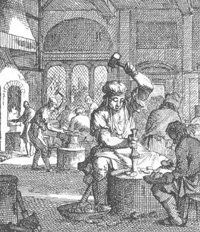
|
Tokens and Medallions
of our Local Area
From Monastic to Modern times
|
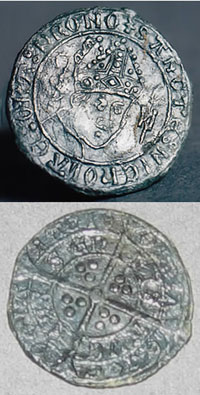
Boy Bishop token
|
Boy Bishop Tokens or St Nicholas Tokens
|
1485
|
These were issued from about 1485 up to around 1535.
Boy Bishop Tokens were ecclesiastical issues of tokens used in Medieval times in the Suffolk area. They show a bishop's head on one side and a long cross on the reverse with three pellets in each quarter.
During the Middle Ages it was customary for churches and abbeys to elect a choirboy as Boy Bishop. He held office from St. Nicholas' Day (December 6th), to Childermas, (December 28th) also known as Holy Innocents' Day, when he preached a sermon and resigned.
In England, the main centre of both production and use of these tokens was Bury St Edmunds, although they were issued in many places on the continent. In Bury the Boy Bishop was in existence by 1418, but the first tokens seem to have been issued from about 1480. They were distributed by the Boy Bishop and probably exchanged for sweetmeats or alms at the Abbey almonry or by charitable local merchants. The distribution of their findspots suggests that they were also used as small change.
|
|
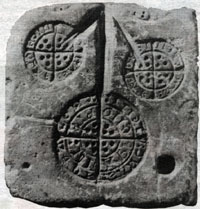
Mould for making tokens
|
|
blank |
The tokens cast at Bury St. Edmunds were based on the coins of the time. They occur in three sizes - penny, half groat (2d), and groat (4d), and were made of lead alloy. The half groat is the least common. The neatest pieces are probably the earliest. Illustrated here is a mould used to produce these tokens, showing the reverse side of the tokens, and used to produce three items at a time. This mould was found in the Abbey grounds in Bury St Edmunds.
The obverse (heads side) usually shows a mitre or the head of St. Nicholas, and often SANCTE NICOLAE (Saint Nicholas). The legend ORA PRO NOBIS (pray for us), asks for his prayers. The reverse (tails) legend is often "AVE REX GENTIS". This is a reference to an anthem sung to St. Edmund in Bury Abbey - "Ave Rex Gentis [Anglorum]" - "behold King of the [English (or Anglian)] people."
In later tokens the legend is usually reduced to a series of strokes or curved lines, while the mitre is often poorly executed. Since the ceremony may have survived the Dissolution of the Monasteries (1535-39) by a few years (Queen Mary is known to have been fond of it), it is possible that this crudeness of execution was deliberate, making as little reference as possible to the Abbey in order to continue the tradition.
By the time of Elizabeth I the Boy Bishop was only a memory. However echos of the design occur on some of the crude, unofficial lead tokens produced locally from the 16th to 18th centuries. This lends strength to the suggestion that Boy Bishop tokens also circulated as small change.
(From a note by Chris Mycock)
|
|
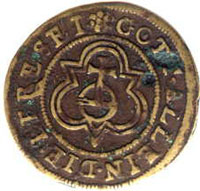
Krauwinkel jeton with Reichsapfel
|
|
blank |
Reckoning Tokens or Jettons
Before the general introduction of the so-called Arabic (really Hindu) numerals in the 15th century, arithmetical calculations in Europe were made by means of the cumbersome Roman numbers. To facilitate accounting, metal discs were used conjunction with a squared board or cloth, in a manner similar to that used with the abacus. The practice continued into the 17th century.
The commonest type of reckoning counter, often found in Suffolk, is that made in Nuremburg by
Hans Schultes (1550 to 1574),
Hans Krauwinkel (1580 to 1610),
Matthew Laufer (1618 to 1625) and
Wolfgang Laufer (1618 to 1660).
They favoured the Reichsapfel (cross on globe) and the winged lion of St Mark the Evangelist, or a pattern of alternating crowns and fleurs-de-lys.
|
|
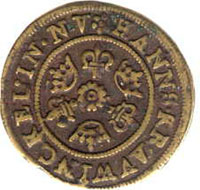
Reverse with crowns
and fleur-de-lys
|
|
blank |
An example was found under one of the apple trees in the grounds of the Institution of Mechanical Engineers in Northgate Avenue, Bury St Edmunds, made of a Copper alloy measuring 24 mm in diameter.
The obverse side shows a reichsapfel (orb and cross within a trefoil border) with a legend of a repeated series of letters, not all legible, but probably "LOBEV". The reichsapfel shows that the token belongs to the 16th and 17th century German series.
The reverse side shows three crowns and three fleurs-de-lys alternating in a circle. The legend seems to have similar letters to that of the obverse, but in a slightly different order.
The legends seem to be meaningless, but may be contractions or the initial letters of a now forgotten phrase, perhaps religious. Many tokens bear a religious motto or a proverb.
|
|
 |
|
blank |
Origins of local Tokens
|
|
1535
|
The remaining ecclesiastical mints at Durham and York were closed by Henry VIII following the Act of Supremacy.
|
|
1536
|
The national coinage was much more uniform from this period onwards and will not be dealt with here. However, there were interesting outbursts of local tokens produced to supplement the national coinage and the locally important tokens are discussed below.
|
|
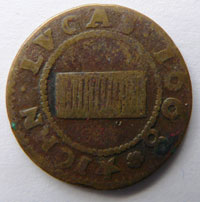
John Lucas - a tobacconist
|
|
blank |
Seventeenth Century Tokens
|
|
|
1649
|
There was no authorised copper coinage under the Commonwealth from 1649 to 1660 and towns and traders started to produce their own. Usually a trader would include his name and his trade would be indicated by a motif or picture related in some way to his occupation.
One motif which is completely obscure to us today, is that included by John Lucas, illustrated here. The picture is of a tobacco bale, indicating his invovement as a tobacco dealer or tobacconist.
Lucas had his business in Bury St Edmunds, and the reverse is shown below at 1668, which is the date on this token.
|
|
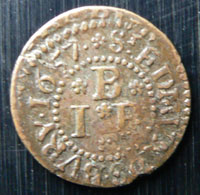
John Baythorne's token
|
|
1657
|
In 1644 the old farthings issued under a Royal Patent by Lord Harrington, and later known as Maltravers farthings, were demonetised. Although a new issue of royal small change was agreed, the Civil War scotched the plans. So there was a growing shortage of small change, which resulted in a few traders issuing their own tokens for one farthing. This started in a small way in 1648 and would build up to a peak between 1666 and 1670.
At Bury St Edmunds, John Baythorne issued this farthing, inscribed "John Baythorne of St Edmundsbury 1657", with the initials I P below a B. It became normal for issuers to include their wife's initials as well, so I stands for John, B for Baythorne, and P was probably his wife's initial.
|
|
1660
|
The shortage of coins continued after the restoration, so from 1648 to 1672 there was an enormous and varied issue of tokens of farthing and halfpenny denominations. There were fewer penny issues. Brass and copper tokens were produced by most traders in most towns and cities.
|
|
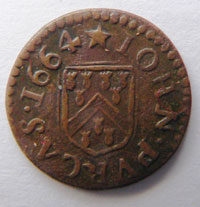
John Purcas of Bury
|
|
1664
|
The token shown here was issued by John Purcas of Bury St Edmunds in 1664. It shows the Grocers Arms, the small items shown representing sticks of cloves.
|
|
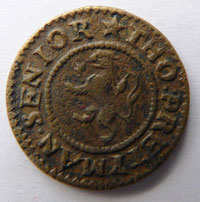
Thomas Prettyman of Bury
|
|
1667
|
The trade token illustrated here was issued by Thomas Prettyman Senior. Presumably he had a son who also operated in the same trade as he felt the need to add Senior to his tokens. The lion may indicate an inn such as the White Lion in Brentgovel Street which may date back to this time. Inn keeping was a respectable and prestigious occupation at this time, and there would always be a need for a good supply of small change.
|
|
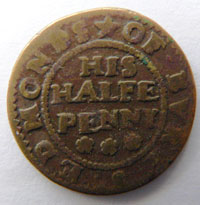
John Lucas of Bury
|
|
1668
|
From 1668 to 1670 the use of Trade Tokens was at its height. This token, issued by John Lucas, a Tobacco dealer or Tobacconist in Bury, is unlike most other Bury tokens. Most tokens refer to the town as St Edmundsbury, in various spellings. Lucas uses Bury St Edmonds as the town name. The reverse of the coin shows a Tobacco Bale as a symbol of his business, and many tokens have a reference to the Traders business in the motif chosen.
|
|
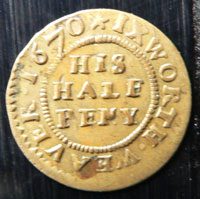
William Syer of Ixworth
|
|
1670
|
By 1670 the private production of farthing or halfpenny tokens, by traders for use as small change, was at its peak. No official coinage of this small denomination had been issued since 1644, and not until 1672 would a new issue be made. The half penny token illustrated here is in brass, made for William Syer, a weaver of Ixworth. Weavers' tokens are very common, but unlike Syer's, the word Weaver hardly ever appears on their tokens. Weavers like William Syer must have been reasonably well off at this time to need a supply of tokens for use by their customers.
You can jump straight to more pictures of 17th Century tokens, fronts and backs by clicking here: Seventeenth Century Tokens.
A 1670 Peterborough halfpenny had eight sides and the legend "Peterburg halfepenny to be changed by the towne bailiff". The reverse had crossed swords. An Ipswich farthing of 1670 has been found as has a square token of William Doggett of 1668, "In Ipswich Grocer his half penny".
|
|
1672
|
In August 1672 the King issued a proclamation that all trade tokens were now forbidden to be made and used. It seems that this was not completely obeyed as another proclamation was issued in 1674.
|
|
1674
|
After 1672, Charles II tried to compensate for the lack of small change and issued large amounts of real copper farthings and half pennies.
Some people lost money when the King issued a new proclamation in 1674 forbidding the issue and use of trade tokens. Traders all over the country including Suffolk, had needed to use their own tokens for small change because of a shortage of royal coinage. Since his proclamation of 1672 also forbidding tokens, the King had managed to get his own new small coins into circulation, and after 1674 the use of trade tokens rapidly died out as they became worthless.
|
|
1679
|
The issue of private tokens was unnecessary by this time and their production was forbidden by law.
|
|
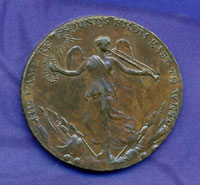
Deck's Penny Token
|
|
blank |
Eighteenth Century Tokens
|
|
1760
|
George III came to the throne. He found that counterfeiting became rampant.
Trade Tokens had last been popular at the end of the 17th century, mainly because of a lack of official small change. They had finally been outlawed in 1674.
|
|
1770
|
George III made a new issue of half pennies, but for the next 20 years, the majority of coins in circulation were forgeries. Many tradesmen took to issuing the own tokens and these were generally worth a half penny.
|
|
1775
|
George III discontinued the making of copper coins in 1775 largely because there had been a great problem with the counterfeiting of the coinage. The huge number of counterfeit coins in circulation would be spent first. Any nice, new, shiny penny would be saved. “Gresham’s Law” acknowledged this fact by stating that “Bad money drives the good money out.” The counterfeiter would gather up the new issues, melt them down, and make 2 or 3 lightweight coppers out of one good one. This just added to the counterfeits in circulation. So after about a decade there was a shortage of good small change.
|
|
1784
|
The original of the token illustrated was thought to be issued by Gurteen's of Haverhill. The illustration is of a copy reissued for the firm's bicentenary celebrations in 1984. It is unclear, but possible that the date on the original was not 1784 but 1794. See 1794, below.
|
|
1787
|
Nationally there was a problem with counterfeit small change. Another reason existed for the rise of this "provincial coinage.". The large cities often had an abundance of coin. Most of it was “bad” coin, but at least it existed. The small towns out in the “provinces” were often completely without coin.
In the more remote places, the problem was more acute. In Anglesey there was a large employer of labour who had the means to do something about it.
In 1787, the Parys Mining Company, who mined copper ore in Anglesey, decided to make their own coins. They had the copper, and they had access to coining presses. Little coin of any kind found its way there. They produced Penny and Halfpenny tokens, of the correct weight, attractive design, and a edge legend that stated they were payable in Anglesey or London by them. They were to prove extremely popular and were soon widely copied.
|
|
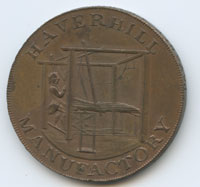
John Fincham's Token
|
|
1794
|
A Haverhill token, known as the Fincham halfpenny shows on one side, a man weaving with the inscription "Haverhill Manufactory". On the reverse is the crest of a Hind's head, the date 1794 and the inscription "Pro bono publico." The token also shows the initials, JF, attributed to John Fincham. According to inscriptions on its edge this token was traded in Hull, South Shields, Chelmsford and London. The loom and motto is still used today by the Haverhill Town Council for its badge.
|
|
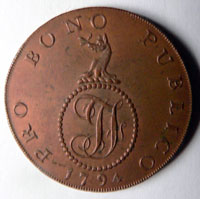
John Fincham reverse
|
|
blank |
In fact the motto "Pro bono publico" was widely used on tokens all over the country. It was meant to indicate that the issue of trade tokens was done, not for profit, or in a desire to deceive, but for public utility as small change. John Fincham was a retailer, and the words "Payable at John Finchams - Suffolk" were inscribed around the token's outer rim. A similar token was found in 1943 during the demolition of Ruffles Mill.
Some factory owners issued tokens to pay their own workers which could only be redeemed in the factory shop or a local store. This practice was perfectly legal until it was stopped by the Truck Act of 1844.
|
|
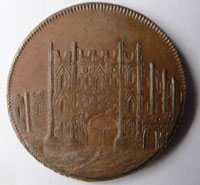
Rackham's Penny Token
|
|
1795
|
During 1795 several Bury traders issued their own half penny or penny tokens. Michael Apsey's token had a kettle and a stove on it with "Success to Trade". On its reverse was the town arms and "Payable at Michael Apsey's." Rackham had a token promoting his new library service, illustrated here. Peter Deck issued another token with his initials over a crown and the legend "The Commerce of Britain". The reverse had the town's arms and "Success to the Plough and Fleece." "Payable at P Decks Post Office Bury" was engraved around the edge.
|
|
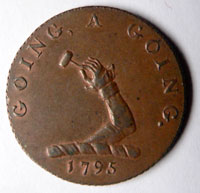
Charles Guest, Bury Auctioneer
|
|
blank |
Charles Guest, an auctioneer had a token showing an arm holdin a hammer with the legend "Going a going". On the reverse it says "Payable at Charles Guests Auctioneer Bury" around a picture of Fame with her trumpet.
The Ironmonger, James Goers simply stated "Payable at James Goers Ironmonger Bury" on one face of his token. The reverse showed the Bury Town coat of arms with the motto "Success to the Plough & Fleece", the same as on one of Deck's issues.
These tokens started life as a substitute for small change, but soon became collectible items of their time. Traders used them to promote the business by giving them to friends and business partners, and while many today are well worn, others have probably never been in circulation.
These tokens can be seen, together with other local tokens, by clicking here: Eighteenth Century Tokens
|
|
1797
|
In 1797 these tokens were again made illegal. In an attempt to kill off the forgeries the famous Cartwheel coinage of one and two pennies was issued made by the new Boulton and Watt Steam presses.
The true definition of a token as compared to a coin, is that a token does not have any intrinsic value. At this time the King and the people believed that a silver coin should contain silver to its face value. So when the King wanted to issue small change in copper to its value in order to kill off tokens, he gave the public another problem.
The new coins were so large that they were termed Cartwheels. This was because they contained either one penny's worth of copper or two pennies worth of copper, which was quite bulky. Even then, collectors retained the two pence piece as a curiosity, as it was too large to be of practical use as a coin. This explains why it is easier today to find a clean example of a cartwheel twopence than a penny, which is nearly always heavily worn from use.
|
|
1799
|
The cartwheel series was extended to half pennies and farthings.
Nineteenth Century Tokens
|
|
|
1806
|
A reduced weight series of half pennies was now issued, but although tokens were made illegal in 1797 there was still a demand for small change.
|
|
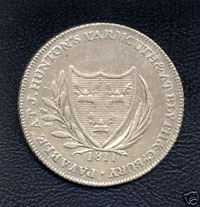
Hunton's Shilling Token
|
|
1811
|
Tokens reappeared in 1811, some silver as well as copper. This one was issued payable at Hunton's in Yarmouth, and at Blyth and Company in Bury, and is dated 1811. The reverse includes the legend "Norfolk and Suffolk Token One Shilling".
|
|
1816
|
These were suppressed by about 1816 when George III had his last recoinage or as it was called the "new coinage". In 1816 the first official coins containing less than face value of silver meant that "tokens" were now official. Steam powered minting machinery replaced the old hand operated presses, and mass production became possible.
Other Tokens
|
|
|
C19
|
A token has been found issued by the Cooperative Society of Wickham Market valued at 10 shillings or half a Sovereign, either from the mid 19th century or later.
|
|
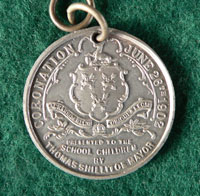
Mayor's Coronation Medal
|
|
1902
|
Coronation medals or tokens were sometimes issued locally such as the examples from the 1902 coronation following the long stable reign of Queen Victoria. An example from Bury St Edmunds was struck by the Mayor, Councillor Shillitoe and distributed to local school children.
Despite the date on the attached medal, King Edward VII was not crowned until August 1902.
The coronation was scheduled for 26th June, 1902, and all the commemorative items were given this date.
At Bury St Edmunds the Mayor, Thomas Shillitoe, decided to issue all the schoolchildren with a commemorative medal, and the June date was placed on it. Unfortunately the King was taken ill in June, and was operated on for appendicitis only a few days before the ceremony was due to take place. The coronation could not take place until August 9th 1902.
|
|
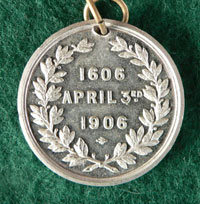
Charter celebration Medal
|
|
1906
|
In Bury, there were big celebrations from April 3rd to the 6th, to mark the 300th anniversary of the town's charter. A special medal was struck which had the town arms on one side and the relevant dates on the other. The charter of 1606 was read out on the steps of the Angel Hotel, and a large crowd gathered for the celebrations.
|
|
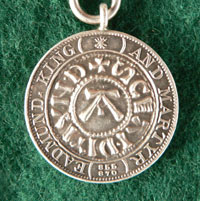
Pageant Medallion
|
|
1907
|
The Bury St Edmunds Pageant Medallion
In 1907 a Pageant of St Edmund and the history of Bury St Edmunds was held in the Abbey Gardens. These medallions were struck as part of the celebrations.
The medallions were sold by the Bury jeweller Thurlow Champness (who, appropriately, played the Goldsmith in the pageant) and advertised in the local papers. The advertisements show that the medallions were made in two different sizes in gold, silver, silver gilt and bronze.
| Metal
| Large | Small/ |
| | Gold | 21/- | 10/6d
| | Silver | 3/- | 1/6d
| | Bronze | 3d | 1d
| | (Silver gilt | 3d extra | 2d extra). |
The central design on both sides is copied from a St Edmund memorial penny now in Moyse's Hall, which was given to the Borough of Bury St Edmunds by Mr John Hargreaves of Liverpool at the time of the pageant. The large A in the centre of the obverse probably stands for 'Anglia'. Otbert, named on the reverse, was the moneyer responsible for striking the coins. The location of the mint is not known.
The reasons behind the St Edmund memorial coinage are not known either, but were probably political. It is possible that the Danes, threatened by invasion from Anglo-Saxon England to the west, tried to rally the support of the East Anglian people by issuing coins in the name of their martyred king. The coins show how quickly the cult of St Edmund became established - he had only been dead about twenty years.
|
|
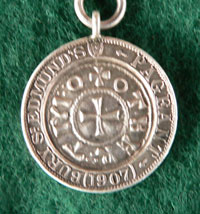
Pageant Medallion reverse
|
|
blank |
The original coin was struck c.890 - c.905 by the Danish rulers of East Anglia in memory of the saint. (However, reports suggest that, at the time of the pageant, people thought it was from King Edmund's reign (855 - 870 AD)). It was found in 1840 in a hoard at Cuerdale (near Preston, Lancashire) in the bank of the River Ribble. The Cuerdale hoard comprised 88lb of jewellery, 'hack-silver' (- broken up objects), and over 7,000 coins. Of these more than 1,000 were English (mostly of Alfred), over 1,000 were Frankish, nearly 5,000 came from Viking-controlled England, and 27 were oriental. The coins date the deposit of the hoard to the very early 10th century. It probably represents Danegeld - a tribute paid to the Vikings so that they would not invade.
Obverse
Outer ring: EDMUND KING AND MARTYR 855-870
Inner ring: + SCEADMVND; A in centre
Reverse
Outer ring: BURY ST EDMUND'S PAGEANT (1907)
Inner ring: + OTBERT MO; cross in centre
(This note from Moyse's Hall Information Sheet 3)
|
Prepared for the St Edmundsbury history project
by David Addy, July 1999
Books consulted:
Seaby's Coins of England
Coincraft's Standard Catalogue of English Coins
Celtic Coinage in Britain - Philip de Jersey
Specimens:
The specimens shown are from private collections.
|






















